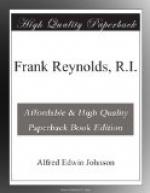Heatherley’s, in Newman Street, London, was his only school. Here, for some time after his final abandonment of commerce for art as the serious business of his life, Reynolds was a close and persistent student. That conscientious care which presents itself to those who are cognisant of his method of work (and, indeed, to any intelligent critic of his finished drawings) as one of his most salient characteristics was a feature of his days of apprenticeship at Heatherley’s. Delight at emancipation from uncongenial occupation was balanced by a sober ambition and a steady purpose. He lived laborious days, laying to heart the lessons of his craft, but he laboured always con amore.
[Illustration: BETHNAL GREEN. From “Sunday Clothes"]
In his student days at Heatherley’s Frank Reynolds received much valuable help from Professor John Crompton. On the vital importance of drawing, the latter was especially insistent: this was the dominant note of his teaching, markedly made manifest in the work of his pupil. In the matter of draughtsmanship, few men have so sure a hand, an instinct so unerring.
[Illustration]
Leaving Heatherley’s, Frank Reynolds set out, armed with a sharp pencil, and a yet sharper sense of humour, to make a living out of black-and-white illustration. His work quickly obtained recognition, and his drawings were soon appearing with regularity in the illustrated press. It would have been strange if Pick-Me-Up, then in its sunniest and most audacious days, had not opened its arms to so keen an observer of life’s little comedies, and Frank Reynolds speedily became one of that clever band which, including at different times such artists in jest as Raven Hill, S. H. Sime, Dudley Hardy, J. W. T. Manuel, Eckhardt, and others, succeeded in making, for a brief but brilliant period, the satirical little sheet in the blue wrapper the most talked of periodical, perhaps, of its day. One recalls with relish many of the quaint conceits that were illustrated in its pages by Reynolds’ mirth-provoking line, and thinks, with regrets for opportunities lost, how admirable a successor he would have been to Raven Hill and “the man Sime” as collaborator with Arnold Goldsworthy in those shrewdly flippant theatrical critiques which the latter contributed over the familiar signature of “Jingle.”
[Illustration: THE REAL ARTIST. From “Paris and Some Parisians"]
It is by his work for the Sketch, however, that Frank Reynolds is best known to the public. Credit is due to that enterprising journal not only for the discrimination which has caused prominence to be given to his drawings in its pages, but for the nice appreciation of the artist’s peculiar vein of humour which has given him a free hand to produce those exquisitely subtle studies of character which are his especial province. As examples of what a humorous drawing should be they are well-nigh perfect. To Reynolds it is not enough merely to depict a laughable situation or superficially comic types. The humour of his drawings is inherent, not extraneous; his pictorial jests are self-contained, so to speak, and the printed legend beneath them is incidental only. Frank Reynolds produces a comedy where other men succeed only in perpetrating a farce.




